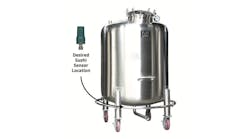Smart field devices can be a smart investment to better manage assets and thus boost competitiveness, says Jane Biddle, vice president of manufacturing research for Boston-based AberdeenGroup in its April 2006 publication “The Asset Management Benchmark Report: Moving Toward Zero Down-time.” That report presents the results of an AberdeenGroup survey that shows best-in-class manufacturers’ current use of predictive/condition-based smart devices is 40% higher than that of other manufacturers.
This would not surprise Gabe Sierra, Emerson Process Management’s Chanhassen, Minn.-based wireless marketing manager. “Intelligent/smart field devices are becoming even more critical throughout industry,” he says. Such sensors typically have embedded microprocessors and, possibly, ad-vanced electronics, so they can analyze, not just generate, data, he notes. Plus, they leverage the increasing use of digital communication protocols for field devices, such as HART and Foundation Fieldbus, to provide informa-tion beyond a primary measurement variable, Sierra adds.
Engineers at PPG Industries in Lake Charles, La., certainly believe that such devices are crucial for its competitiveness. Five years ago, techni-cal staff at the facility, which manufactures chlorine, caustic soda, sodium hydroxide, silica products, vinyl chloride monomer and other chemicals, asked one another, “Do we need smart transmitters?” says Tim Gerami, sen-ior design engineer, instrumentation, for plant-wide operations. “Yes,” he remembers they answered. “The smart sensors are easier to calibrate. They give asset management information. They’re more accurate. And they’re more reliable.”
PPG uses Emerson Process Management’s Rosemount 3095 multi-variable mass flow transmitter to replace single transmitters, Gerami notes. “We probably have 20 to 30 of the 3095s throughout the plant. We’ve been able to calculate compensated flow in the field, rather than in the control room.”
Condition monitoring role
A good use of smart sensors is condition monitoring, says Bill Nickerson, technical director and vice president of RLW Inc., State College, Pa. True smart sensors convert raw data into actionable information at the sensor, he explains. Then, the sensor backs up its assessment with corroborating infor-mation. “The user will demand this (functionality) if condition monitoring — or condition-based maintenance — is to become the norm, rather than the exception,” he predicts.
“A smart control valve not only lets maintenance personnel know if its [the valve’s] operation is below par, but often signals what’s wrong and what’s needed for a fix,” says Neal Rhinehart, director of performance tech-nologies for Fisher valve and instrument products at Emerson Process Man-agement, Marshalltown, Iowa, and author of a recent article on control valve maintenance (CP, March, p. 47).
Smart sensors also are playing roles elsewhere, including in process safety and plant availability. Most applications of any type rely on wired im-plementations, but wireless smart sensors are gaining ground.
Conditioning monitoring greatly concerns PPG. “We have thousands of applications in the plant for condition monitoring,” Gerami explains. “We’re looking at the following: The smart device needs to have multiple inputs to look at various temperatures and various accelerometers to look at vibration.” Now, though, the company has mechanical switches that send vibration information.
But switches can fail to trip. “And sometimes you don’t know until it’s too late,” Gerami admits. Case in point: PPG recently lost a $40,000 mo-tor at one of its units. “If we’d had a simple $500 device on it, we’d have shut the motor down before it vibrated itself to death,” he says.
Such monitoring is precisely what RLW’s smart sensors were de-signed for, asserts Nickerson. Its S2NAP sensors suit situations demanding complex data to describe the condition of some piece of equipment. The wireless devices transmit machinery health data gathered from a variety of analog sensors, including ones for vibration, pressure, temperature, level, current and voltage. “We monitor machinery, pumps, cranes, motors, turbo-generators, etc.,” he explains.
Safety and availability
Regardless of how the sensors are tied in, they must play a role in process safety, says Roy Schuyler, a retired DuPont engineer who now runs Organ-izational Improvement in Avondale, Pa. After all, process safety measures provide the ultimate on-site asset protection and require companies to keep tabs on piping systems, reactors, tanks and towers. “I see smart sensors gain-ing further entry into chemical plants wherever the consequences of failure are horrific and unacceptable,” he says.
Smart monitoring to prevent production loss is also important, Shuyler notes, citing the need to monitor rotating equipment such as pumps, com-pressors, fans and motors; heat exchangers; and solids-handling equipment.
For both safety and availability, the analysis and inference provided by smart sensors can drive risks lower by reducing the frequency of failure, he says. “But how you monitor depends on the kind of equipment and its na-ture — and also the environment in which that equipment operates.”
The decision to use smart sensors — and where they’re used — should be driven by reliability considerations and a risk-assessment method-ology, he notes. Plants generally have historical information that shows their weak points and that, thus, can help in making decisions about where to use smart sensors. However, he believes what ultimately steers a manufacturer’s use of these sensors is the economic bottom line.
Corrosion monitoring
One common plant weak point is corrosion of piping or process vessels’ in-ternals. What’s needed is a smart device that can find the change in process corrosivity before it creates significant damage, says Russell D. Kane, direc-tor of corrosion services for Honeywell Process Solutions, Houston. “I’ve heard so many [end-users] say, ‘It’s not during operations that I have prob-lems, but at startup and shutdown. So if I can control corrosion, I may be able to extend the run life of the equipment.’”
For instance, Kane cites results at one BASF plant in which a hydro-carbon was mixed with a catalyst, heated and then oxidized. Before install-ing Honeywell’s SmartCET corrosion monitor, which provides online, real-time information and interfaces to a control system using HART, BASF could only assess corrosion problems offline. But within weeks after install-ing the multi-probe sensor, BASF correlated corrosion events with process events. Now such events can be correlated within seven minutes, allowing action to minimize corrosion.
Bayer Technologies Services, Baytown, Texas, uses a SmartCET cor-rosion monitor in a continuous, gas-phase reactor made of a molybdenum alloy, explains Chak Wong, an engineering consultant at the firm. The sen-sor’s probe is installed at the vessel’s inlet, where Bayer finds corrosion oc-curs more than elsewhere in the reactor. “The corrosion problem might be due to condensation, due to the phosphorous-based catalyst being used,” he says. “And it [corrosion] might be during backflow, when the unit is idle.” The estimated corrosion rate was 0.5 mils to 2 mils annually, measured by the SmartCET monitor during its first four months of use, Wong notes, which matches the acceptable annual rate of 1 mils to 2 mils.
However, one weekend, during a 30-hour period, the rate reached about 100 mils annually. “It was traced back to process condition during the idling period,” he explains. “And human error caused no nitrogen blanketing during that time.” The corrosion sensor’s observations matched almost one-to-one the actual operating conditions that caused the spike, adds Wong. The process conditions were changed to prevent further occurrences.
Currently, Bayer Technologies uses one Honeywell unit but is looking at installing another in a second, identical gas-phase reactor in the same op-erating unit, Wong says. “And we’re also adding some more SmartCET units in Baytown at another operating unit.” He adds that Bayer has many more such sensors installed at its European facilities.
Value for valves
Piping and vessels, of course, aren’t the only concerns at plants. The multi-tude of valves controlling flow also demand serious attention. “Today’s technology allows fault detection and analysis while the valve is in normal operation — i.e., online and in-service,” says Rhinehart.
Houston-headquartered Tapco International Inc., a subsidiary of Cur-tis-Wright Flow Control Corp., produces slide valves with smart-sensor technology for service with refinery fluid catalytic crackers (FCCs) and uses the TA-12 explosion-proof linear position transducer from Balluff GmbH, Neuhausen, Germany, in those valves. “We put it inside of a cylinder and that’s part of the actuator of all the slide valves we manufacture,” notes Dan Do, a Tapco project design engineer. “The TA-12 can also be used on butter-fly and plug valves.”
This transducer provides condition feedback — valve position — adds Scott Rosenberger, product-marketing specialist with Balluff USA, Flor-ence, Ky. “It mirrors what the actuator is doing and transmits that informa-tion to a device that has the intelligence capabilities to process that informa-tion.”
Tapco’s valves are part of the critical control for refineries and are ex-pected to operate continuously, Do explains. With the Balluff device, if a problem occurs with electronics in the transducer, it can be removed without interfering with valve operation. “We’re not allowed to depressurize and lose control of the valve,” Do says.
A wireless future
Wireless devices certainly seem set to play an increasing role. PPG, for one, would like to use wireless smart sensors more, Gerami says. “We’re jumping into the wireless arena like crazy. Wireless condition monitoring might be a great way to get started.” For process safety, he foresees wireless usage with equipment such as relief valves and rupture disks. Coupled with an acoustic or pressure sensor, the smart wireless device could show when overpressure protection has been actuated.
There’s also a need for a wireless smart sensor at a safety shower, he believes. “If someone is using it, that person is obviously in trouble. So it would be useful to know when it’s been actuated, so that we could send the response team to assist.”
Vendors certainly are responding by introducing more wireless smart devices. For example, ITT Industries Inc., Seneca Falls, N.Y., in December 2005 launched its PROSmart wireless machine-health monitoring system. Designed to replace traditional walk-around inspections of rotating equip-ment such pumps, motors, fans and compressors, the device collects, trends and displays data, as well as sounding alarms via cell phones, e-mail, pagers and a Web-based browser.
The chemical industry should keep its eyes focused on wireless, says Sierra, because its use is definitely due for a dramatic increase to enhance monitoring, control and asset management. “The reason is simple,” he ex-plains. “A 20-plus-year-old plant in Illinois will need to effectively compete with a brand new state-of-the-art facility overseas.”
But whether wireless or not, smart sensors will continue to gain stat-ure and usage in the chemical industry for good reason. “Smart devices have the intelligence to determine and communicate information about the asset’s health status, in addition to whatever else is communicated in their opera-tional role,” states Biddle. Worth noting: Those assets could include people, not just machinery.

